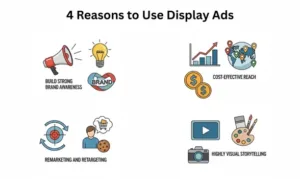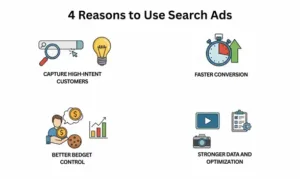The key difference between search ads vs display ads lies in how they reach people. Search ads appear when users actively look for something on Google, while display ads show visual banners or videos across websites, apps, or YouTube to reach people even if they are not searching.
How Do Search Ads Work?
Search ads are triggered when someone types specific keywords into Google. Advertisers bid on those keywords, and the ads appear above or below the organic search results.
These ads are usually text-based, containing a headline, description, and a link to a landing page. They look similar to search results but are marked as “sponsored” or “ad.”
Because they target people actively searching, search advertisers can capture intent-driven traffic. For example, someone searching “best running shoes online” is highly likely to click a search ad from Nike or Adidas.
Search ads run on a pay-per-click (PPC) model, meaning businesses pay only when users click. This ensures that budgets go toward actual engagement, not just impressions.
In short, search ads connect businesses with people at the moment of intent, making them one of the most effective forms of online advertising.
How Do Display Ads Work?
Display ads are visual ads in the form of images, banners, or videos that appear across Google’s Display Network, which covers millions of websites, apps, and YouTube.
Unlike search ads, display ads don’t rely on keyword searches. Instead, they use targeting like demographics, browsing behavior, or interests to show ads to the right audience.
For example, if someone visited an e-commerce store for furniture but didn’t buy, display ads can retarget them later on another site, reminding them of the products they viewed.
This makes display vs search advertising different: search ads capture intent, while display ads create awareness and keep brands visible even outside search engines.
Display ads usually work on cost-per-click (CPC) or cost-per-thousand-impressions (CPM), making them flexible for both engagement and brand exposure campaigns.
What Are the Benefits of Search Ads?
One of the biggest benefits of search ads is high-intent targeting. People searching for keywords like “buy iPhone 15 online” or “emergency plumber near me” are already ready to take action.
Search ads also provide fast results. Unlike SEO, which takes months, running a paid campaign can instantly place a brand at the top of Google’s results.
Another advantage is measurability. Every click, impression, and conversion can be tracked. This allows advertisers to optimize campaigns based on real-time data.
Search advertisers also enjoy a high return on ad spend (ROAS) because budgets are spent only when someone clicks. According to industry data, the average conversion rate of search ads is around 4–6%, significantly higher than display campaigns.
Additionally, search vs display advertising favors businesses with limited budgets. Even a small campaign targeting high-intent keywords can drive quality leads.
What Are the Benefits of Display Ads?
Display ads shine in brand awareness. Since they appear across millions of sites, they can expose a brand to a massive audience even before someone thinks about searching.
They are also visual and creative, using images, animations, or videos. This makes them more engaging compared to plain text ads, especially for storytelling and emotional impact.
Another benefit is remarketing. With display ads, businesses can retarget people who visited their site but didn’t purchase. Research shows remarketing ads can boost conversion rates by up to 70%.
Display advertising also helps with top-of-funnel marketing. For example, a new fitness app can use display ads to spread awareness before people even think of searching for “workout apps.”
When comparing display ads vs search ads, display often delivers a lower cost-per-thousand-impressions, making it more affordable for brands seeking exposure.
When Should You Use Search vs. Display Ads?
Search ads are best when the goal is immediate conversions from people who are actively searching. For example, service providers like locksmiths or lawyers benefit most from search campaigns.
Display ads are ideal when the goal is awareness, visibility, and long-term branding. A startup launching a new product can use display campaigns to build recognition before people begin searching.
In display vs search advertising, the decision often depends on the customer journey stage. Search ads target demand that already exists, while display ads create and nurture that demand.
A balanced marketing strategy often uses both. Use search ads for bottom-of-the-funnel conversions and display ads for top-of-the-funnel awareness.
4 Reasons to Use Display Ads

Build Strong Brand Awareness
Display ads are powerful for building recognition. Since they appear across millions of websites and apps, they keep a brand in front of potential customers even when they’re not searching. This top-of-funnel strategy helps businesses stay memorable.
Cost-Effective Reach
Compared to search, display ads often deliver a lower cost per thousand impressions (CPM). This allows advertisers to reach wide audiences with smaller budgets, making them ideal for startups or brands focused on exposure.
Remarketing and Retargeting
One of the biggest strengths of display vs search advertising is remarketing. Businesses can show ads to users who previously visited their site but didn’t buy. These reminders increase the chances of conversion significantly.
Highly Visual Storytelling
Unlike text-only search ads, display campaigns allow images, videos, and animations. This makes them perfect for showcasing products, building emotional connections, or telling a brand story in a more engaging way.
4 Reasons to Use Search Ads

Capture High-Intent Customers
Search ads target people at the exact moment of intent. Someone typing “buy winter jacket online” is actively looking to purchase, making them more likely to convert compared to someone casually browsing a website.
Faster Conversions
Because search advertisers reach users ready to act, conversions often happen more quickly. For local businesses like electricians, locksmiths, or plumbers, search ads can drive immediate calls and inquiries.
Better Budget Control
Search ads operate on a pay-per-click model. Advertisers only pay when someone clicks, ensuring budgets are spent efficiently. This makes them especially useful for small businesses with limited marketing funds.
Stronger Data and Optimization
Search campaigns provide detailed insights into keyword performance, click-through rates, and conversion data. Advertisers can continuously refine targeting and bidding strategies for maximum return on ad spend (ROAS).
Can You Use Both Together?
Yes, many businesses combine search and display ads to maximize performance. While search ads drive immediate sales, display ads build awareness and keep the brand in front of potential customers.
Google itself encourages combining strategies. Beyond search vs display ads, Google offers 9 ad types: Search, Display, Video, Shopping, App, Smart, Local, Discovery, and Performance Max. Each serves a unique role in the advertising funnel.
For example, an e-commerce brand might use search ads to target “buy running shoes online,” display ads to retarget visitors, and video ads to showcase new collections on YouTube.
Using both creates a full-funnel approach. Display vs search advertising doesn’t have to be a choice—it’s about alignment with business goals.
Conclusion
The debate of search ads vs display ads isn’t about which is better—it’s about when and how to use each. Search ads excel at capturing high-intent traffic ready to convert, while display ads shine at building brand awareness and retargeting potential customers.
Businesses that want immediate results should lean into search advertising. Those aiming for broader visibility and long-term recognition should prioritize display campaigns.
But the most effective approach is a mix. By combining search vs display ads, businesses can cover the entire customer journey—from awareness to conversion—and achieve stronger results.
In today’s competitive digital landscape, search advertisers who understand the difference between display vs search advertising can strategically allocate budgets, drive more conversions, and maximize growth.




